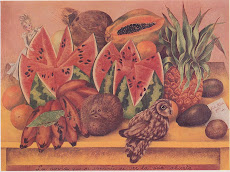In my first post to this blog, I failed to mention what brought me to Ian’s work in the first place, which was quite transformative for me. Reading the ‘Following’ paper as a graduate student helped me along the way in my art practice and affirmed some of the feelings I had regarding my work. The story of Shelly Sacks’ installation, “Exchange Values: Images of Invisible lives,” really hit me. Ian takes an art installation from the white cube into the supermarket and then to the classroom and back out to the market. As an artist and educator, I was fascinated by Ian’s performance, activating Shelly’s gallery work and making it more accessible with the notion of transforming, mixing if you will, art practice with other disciplines. The resulting experience becomes much richer than a visit to the gallery and is more likely to provoke a continued dialog. This is exactly what I was looking for in my own work. Showing in galleries always seems to fall a bit short, feeling more like a gesture than affecting social change.
At the time ‘Following’ was given to me, I was also working on my MFA thesis project, which brought together a group of artists, scientists, activists, historians and sociologists to examine alternative forms of food production, as well as the stories behind them. My personal project was cloning organic vegetables via an art installation (BioArt), but I was more interested in the conversations surrounding food production/consumption that were taking place in other fields of study. It seemed natural to organize an exhibition and symposium that would address our mutual interests. Some of the participants included sociologist Melanie DuPuis (Angels and Vegetables: The Birth of Food Advice in the US), activist Claire Pentecost (What Did You Eat and When Did You Know It?), artists Claude Willey + Deena Capparelli (Food, Fossil Fuels, and Climate Change: The Bizzare Love Triangle), and Director of the Plant Transformation Center at UC Riverside, Dr. Martha Orozco-Cardenas. The exhibition, “Bioneering: Hybrid Investigations of Food," provided a venue for exploration of the arts through multiple vantage points, also questioning the efficacy of the gallery to discuss social issues. We used the internet to broadcast panel discussions and had them available for viewing in the gallery, as well as performances at the opening reception. A catalogue was produced to accompany the exhibition, with a website for the project and video of the symposium: http://www.foodbioneers.com. Ian was kind enough to give me permission to use the ‘Following’ paper in the catalogue, containing the papers mentioned above and others.
The outcome of all the discussion and activity with practitioners in a post-discipline environment was overwhelming. It created a new kind of aesthetic encounter. Individual projects were shared in the fields of science, visual art, architecture, graphic design, urban planning, education, theater, sociology, and engineering. Each piece had some aspect of food production, consumption or distribution in mind, but what is remarkable are the dynamic interactions that took place across discipline lines and the cooperative nature of our exchange. Plans were made to begin new projects or collaborate on continuing work. There was an excitement in the air that is difficult to describe, but was definitely felt. Working across disciplines generates a form of excitement and novelty that leads to exploration.
The hurdle now seems to be getting everyone together, which I think this blog addresses. As I’ve read the many posts made by social scientists, it is intimidating at first, because the way I do research is so different than yours, but the ideas generated are worth the risk. There is a forum here to share information and hopefully help one another with our projects– or at the very least, find source material to investigate. In a way, I feel like I’m looking through a keyhole at a completely different world, but on the other hand we all seem to be interested in similar topics. The way we communicate is just a little different. I work with an organic chemist in San Francisco on some of my projects. We started out chatting online and now do most of our work on msn, with occasional face-to-face visits. His expertise in science has helped me to develop two major projects thus far, though sometimes it takes us awhile to explain how each other’s world works in order to make progress. In the end, it’s worth it. Art informed by social science or other fields of study are rich not only experientially, but the finished work is more complex and open to a much larger audience. On the flip-side, I can also see how art may be a useful tool for social scientists, as Ian demonstrated with Shelly’s piece. It seems that both disciplines reach a limited audience and have a tough time affecting real change. Perhaps together we can change that?
Wednesday, September 3, 2008
Subscribe to:
Post Comments (Atom)

No comments:
Post a Comment